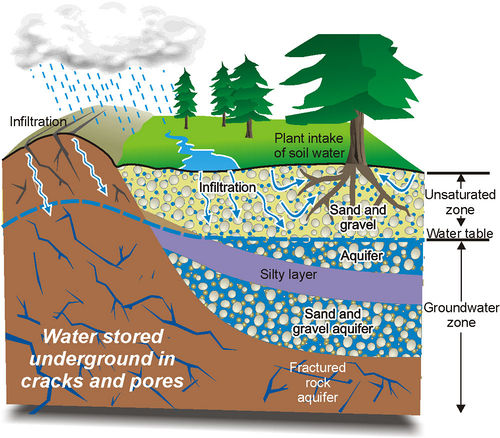Groundwater: Difference between revisions
No edit summary |
No edit summary |
||
| Line 4: | Line 4: | ||
==Physical environment== | ==Physical environment== | ||
===Substrate and sediment=== | |||
In the shallow aquifers where generally groundwater is located, typically, there is soil, sand, plant roots, hardpan and low permeability bedrock. | |||
=== | ====Temperature==== | ||
The temperature of groundwater is quite steady because the specific heat capacity of water is high and also because the soil, rock and up layer water protect groundwater from heat changing with the climate. | |||
====Hydrogeology==== | |||
Groundwater is relatively stable compared to surface water. In the aquifer and other porous media, groundwater not only follows gravity, but also follows pressure gradients. The movement of groundwater also depends on the porosity, water content and hydraulic conductivity of aquifer. | |||
===Groundwater contamination=== | |||
Pollutants, such as gasoline, oil, road salts and chemicals seep into groundwater can hurt animals, plants, or humans. Two major contaminate sources are Hazardous waste site leaking and landfills. Since groundwater is part of hydrologic cycle, contaminates released to the groundwater could create a contaminant plume within an aquifer and also can be transferred to the other parts of the cycle. | |||
==Microbial communities== | ==Microbial communities== | ||
| Line 18: | Line 22: | ||
Are there important biological interactions that are important in this environment? Do these interactions influence microbial populations and their activities? How do these interactions influence other organisms? Describe biological interactions that might take place in this environment, using as many sections/subsections as you require. Look at other topics available in MicrobeWiki. Create links where relevant. | Are there important biological interactions that are important in this environment? Do these interactions influence microbial populations and their activities? How do these interactions influence other organisms? Describe biological interactions that might take place in this environment, using as many sections/subsections as you require. Look at other topics available in MicrobeWiki. Create links where relevant. | ||
=== | ===Groundwater contamination=== | ||
====Subsection 1a==== | ====Subsection 1a==== | ||
====Subsection 1b==== | ====Subsection 1b==== | ||
Revision as of 21:36, 4 April 2011
Introduction
Surface water moves downward through unsaturated zones –typically tiny pores and cracks in the soil, sand, or rock, and then reaches a stable and completed water saturated layer named water table. Groundwater is beneath the water table. Groundwater provide about 0.6 percent of the world’s total water and 20 percent of the available fresh water resources. Microbial organisms play important role in groundwater ecosystem and affect drinking water quality significantly. Microbial contamination of groundwater is a big concern.
Physical environment
Substrate and sediment
In the shallow aquifers where generally groundwater is located, typically, there is soil, sand, plant roots, hardpan and low permeability bedrock.
Temperature
The temperature of groundwater is quite steady because the specific heat capacity of water is high and also because the soil, rock and up layer water protect groundwater from heat changing with the climate.
Hydrogeology
Groundwater is relatively stable compared to surface water. In the aquifer and other porous media, groundwater not only follows gravity, but also follows pressure gradients. The movement of groundwater also depends on the porosity, water content and hydraulic conductivity of aquifer.
Groundwater contamination
Pollutants, such as gasoline, oil, road salts and chemicals seep into groundwater can hurt animals, plants, or humans. Two major contaminate sources are Hazardous waste site leaking and landfills. Since groundwater is part of hydrologic cycle, contaminates released to the groundwater could create a contaminant plume within an aquifer and also can be transferred to the other parts of the cycle.
Microbial communities
What kind of microbes do we typically find in this environment? Or associated with important processes in this environment? Describe key groups of microbes that we find in this environment, and any special adaptations they may have evolved to survive in this environment. List examples of specific microbes that represent key groups or are associated with important processes found in this environment. Link to other MicrobeWiki pages where possible.
Are there important biological interactions that are important in this environment? Do these interactions influence microbial populations and their activities? How do these interactions influence other organisms? Describe biological interactions that might take place in this environment, using as many sections/subsections as you require. Look at other topics available in MicrobeWiki. Create links where relevant.
Groundwater contamination
Subsection 1a
Subsection 1b
Subsection 2
Microbial processes
What microbial processes define this environment? Describe microbial processes that are important in this habitat, adding sections/subsections as needed. Look at other topics in MicrobeWiki. Are some of these processes already described? Create links where relevant.
Subsection 1
Subsection 1a
Subsection 1b
Subsection 2
Current Research
Enter summaries of recent research here--at least three required
References
Edited by <your name>, a student of Angela Kent at the University of Illinois at Urbana-Champaign.

